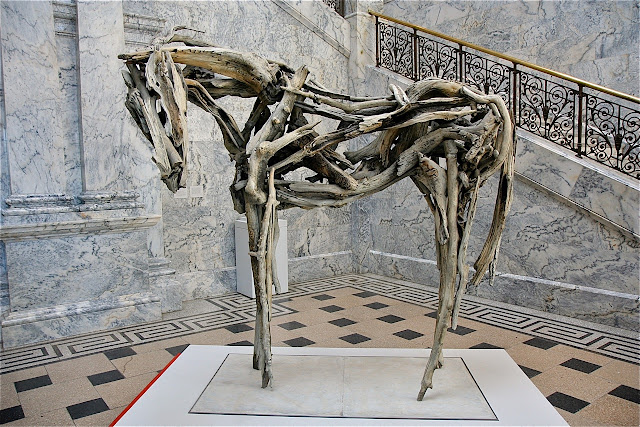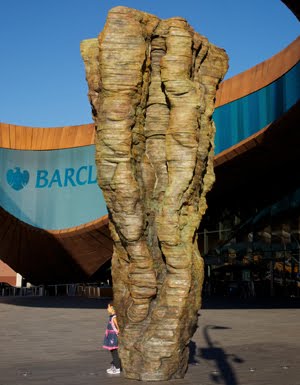Deborah Butterfield is one of the most popular living American sculptors. It sometimes seems like every museum in the country has one of her works. Her sculptures are easy to like and instantly recognizable because they depict horses—an appealing subject—in a warm and sympathetic manner, as though each were a portrait of a special friend.
The mysterious part of Deborah's work is that while most of it appears to be made of driftwood and scrap lumber, it is actually made from cast bronze with a patina that matches the natural material exactly. The process is quite complicated. Deborah builds the original maquette from organic materials, then disassembles it, and covers each separate piece with a ceramic-shell molding material that is capable of picking up exacting detail. The wood is completely burned away during firing. The mold is then used for the bronze casting.
In her treatment of horses, Deborah rejects the bold stallions of traditional equestrian sculpture and the association of horses with war. By using humble scrap materials—whether scrap metal or twigs and branches—Deborah creates humble images of docile mares who seem as vulnerable as people.
Deborah began exhibiting in the 1970s, and her work was quickly accepted. She has continued building expressive horses unto the present, when she is in her mid-60s.
 |
| Deborah with a collection of driftwood and scrap on her ranch near Bozeman, Montana |
Background: Deborah was born in San Diego, on the day of the 75th Kentucky Derby. Nothing is indicated anywhere online about her parents or upbringing.
Training: Deborah earned both a B.A. and an M.F.A. at the UC Davis.
Private life: In 1974, when she was 25, Deborah married an artist that she met while attending the University of California at Davis named John Buck. They have two sons. From 1976 to 1990, John was an assistant professor of sculpture at Montana State University in Bozeman.
 |
| John Buck, born 1946 |
 |
| Deborah and John in 2010 when they received an Arts Award from the Governor of Montana |
John Buck is a very interesting artist whose work is as varied in form, content, and materials as Deborah's is unified. The few examples available on the internet suggest that his art is highly innovative and deeply thoughtful, but his work is not widely exhibited. Here is one of his most interesting pieces. It was advertised by the Greg Kucera Gallery in Seattle for $32,000.
 |
| John Buck Arch of Constantine, 2012 Jelutong wood, 66" tall Internet |
Deborah and John divide their time between a ranch with separate studios for each near Bozeman, Montana and studio space in Hawaii. Deborah also must spend a lot of time in Walla Walla, Washington, where her foundry is located.
 |
| Deborah working in her Hawaii studio |
Our photos of Deborah's Horses
 |
| Aluminum Horse #3, 1982 San Diego / Jan's Photo, 2017 |
 |
| Orion, 1988 Denver / Jan's photo, 2010 |
 |
| Second Daughter, 1989 Toledo Photo by Dan L. Smith, 2006 |
 |
| Pohina, 2001 San Francisco Airport / Jan's photo, 2015 Cast bronze with patina |
 |
| Half Moon, 2007 Figge / Jan's photo, 2010 |
 |
| Tarkio, 2011 Flint / Jan's photo, 2013 |
 |
| Horse at Cantor Museum, no title, no date given Photo by Dan L. Smith, 2009 |
Internet grabs
 |
| Horse, 1976 Mud and Straw on armature with horseshoes 6 1/2 feet tall / Internet |
 |
| Horse #5, 1978 Mud, sticks, wire, ground paper, dextrine and steel SFMOMA / Internet |
 |
| Untitled, 1983 Scrap metal from an Air Stream trailer 5th & J, Sacramento / Internet |
 |
| Ferdinand, 1990 Found steel, 6 ft tall Internet |
About the sculpture below, Deborah gets scrap metal by the ton from a salvage yard in Rockford, Illinois. When this pile of rebar arrived at her studio, with its large chunks of concrete still attached, she included it in the sculpture.
 |
| Rockford, 2013 Welded found steel with concrete Greg Kucera Gallery, sold sculpture / Internet |


































